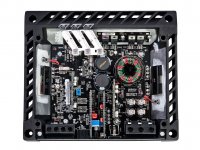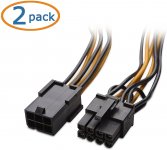good morning just to check if I understand how these amps work
Practically their internal power supply is made up of a dc-dc converter that takes the 12VDC input and generates the dual voltage necessary to make the amp work?
so with some modifications they could also be fed directly with a dual voltage like a normal home amp?
the reason is that there are really good deals in the car audio these days and I'm sure some of the best products can have excellent sound performance indeed
As a first approach to diy it would be much easier for me to put blocks together ... just adding a transformer a sturdy diode bridge and two decent capacitors and voila a great little power amp is done ?
I see just to say some amps from the legendary brand Fosgate at just 200USD in used equipment ... and they look really really serious.
Am I thinking of something electronically perverse?
Practically their internal power supply is made up of a dc-dc converter that takes the 12VDC input and generates the dual voltage necessary to make the amp work?
so with some modifications they could also be fed directly with a dual voltage like a normal home amp?
the reason is that there are really good deals in the car audio these days and I'm sure some of the best products can have excellent sound performance indeed
As a first approach to diy it would be much easier for me to put blocks together ... just adding a transformer a sturdy diode bridge and two decent capacitors and voila a great little power amp is done ?
I see just to say some amps from the legendary brand Fosgate at just 200USD in used equipment ... and they look really really serious.
Am I thinking of something electronically perverse?
You can feed some of them with external supplies but most complicate things with regulated ±15v power supplies, protection and muting circuits.
Not all output stages in amps work from split rails. Some class D have a single positive rail for the output stage and use a split supply for the preamp section.
Not all output stages in amps work from split rails. Some class D have a single positive rail for the output stage and use a split supply for the preamp section.
Thanks a lot for the very helpful advice
In the meantime i was thinking why not open one and measure voltages around ? that would tell one or two things
But seriously i admire their construction ... is so neat and compact
At the shops some are put on display with plexiglass tops ... and the look is amazing .... works of electronic art.
In the meantime i was thinking why not open one and measure voltages around ? that would tell one or two things
But seriously i admire their construction ... is so neat and compact
At the shops some are put on display with plexiglass tops ... and the look is amazing .... works of electronic art.
Attachments
Last edited by a moderator:
Hi ! i hope in the weekend to start with some tests ... i see a trimmer for fine regulation of the Vout ... maybe some 13.5V are possible i have to check
However these amps are Ampere suckers ... i have seen some measurements on youtube ... they seem welders 😱
However these amps are Ampere suckers ... i have seen some measurements on youtube ... they seem welders 😱
The current draw is relative to the output power to the speaker. As an example, a 1000w amplifier may draw 150+ amps at full power but at lower volume, it may not draw more than 5-10 amps.
 Gino. Please stop quoting the entire post just above your own post. We do not do that on this forum. Recently changes were made to the forum software to make it more difficult to do so. I have cleaned up a number of your posts.
Gino. Please stop quoting the entire post just above your own post. We do not do that on this forum. Recently changes were made to the forum software to make it more difficult to do so. I have cleaned up a number of your posts.Thanks. I did not think about this 😱 I have one last silly questionThe current draw is relative to the output power to the speaker....
Will using a bigger amp provide any benefit compared to using a smaller amp for a same output power ? 😱
Last edited:
Yes exactly. Maybe it will be less stressed because of its superior power capability or show a better control on difficult load (i.e. 2 ohm)Are you asking ...
Some speakers can have a dip of the impedance curve ...
A higher power amplifier will be less efficient than a lower power amplifier. If all you will ever need is 100w, a 100w amplifier will run cooler and draw less current than a larger amplifier.
Forget about the current to the speakers. <<< Seriously! These are amplifiers that use global feedback, not tube amplifiers. If you have an amplifier that's designed to drive the load that you present to it, it will drive that load. The design engineers design amplifiers for a living and know what complex load that speakers can be.
Forget about the current to the speakers. <<< Seriously! These are amplifiers that use global feedback, not tube amplifiers. If you have an amplifier that's designed to drive the load that you present to it, it will drive that load. The design engineers design amplifiers for a living and know what complex load that speakers can be.
Thanks ! no more silly question I think that soon i will have a little collection of small power amps. I like the attenuators at the inputs ... very handy for me that i have spent life struggling with too high gain from the preamps 🙁A higher power amplifier will be less efficient than a lower power amplifier....
Please post the results when you get the amp. Is it quarantine since it takes so long? 😉
Cheers!
Cheers!
Hi yes ! but for me it has been very important to establish that bigger does not mean necessarily also better sound quality
I am looking at high efficiency speakers ... maybe even with horn loaded mid-tweeters ... so the need of power is very limited
However i have looked at low power amps from Fosgate for instance ... usually intended to power mid and tweeters ... so i guess they have a very clean sound They are not cheap even very old ... a sign of quality i guess.
I will try this MDS ... but i am willing to buy something very good a possibly final.
Thanks a lot again. Have a nice day, gino
I am looking at high efficiency speakers ... maybe even with horn loaded mid-tweeters ... so the need of power is very limited
However i have looked at low power amps from Fosgate for instance ... usually intended to power mid and tweeters ... so i guess they have a very clean sound They are not cheap even very old ... a sign of quality i guess.
I will try this MDS ... but i am willing to buy something very good a possibly final.
Thanks a lot again. Have a nice day, gino
Last edited by a moderator:
In the meantime i have also received a Dell DA-2 power supply ...
Redirect Notice
it looks really serious
Hope not to have difficulties in connecting it right to the car amp
i am thinking about buying these
Cable Matters Pacco da 2 Adattatore PCIe 6 Pin a 8 Pin – 4 Pollici: Amazon.it: Elettronica
they should simplify things ?
Redirect Notice
it looks really serious
Hope not to have difficulties in connecting it right to the car amp
i am thinking about buying these
Cable Matters Pacco da 2 Adattatore PCIe 6 Pin a 8 Pin – 4 Pollici: Amazon.it: Elettronica
they should simplify things ?
Attachments
It should be without fan but i can't open it
i do not have the right screwdriver. It is sealed with no vents visible
i do not have the right screwdriver. It is sealed with no vents visible
It's designed to run as it. If you open it, be aware that it's not designed to be safe when opened. Any of the various components, frame, heatsinks... could have high voltage on them.
Hi thanks for the very kind advice I got the question about the presence of a fan in the email but i don't see it here From now on i will be looking for small power stereo car amp with no big needs of Ampere but with a nice sound I have already bought another one of this Dell power supply I understand that are designed for heavy duty? I don't know about their mtbf Thanks a lot again
- Home
- General Interest
- Car Audio
- Anyone using a car audio amp in a home stereo set-up?


